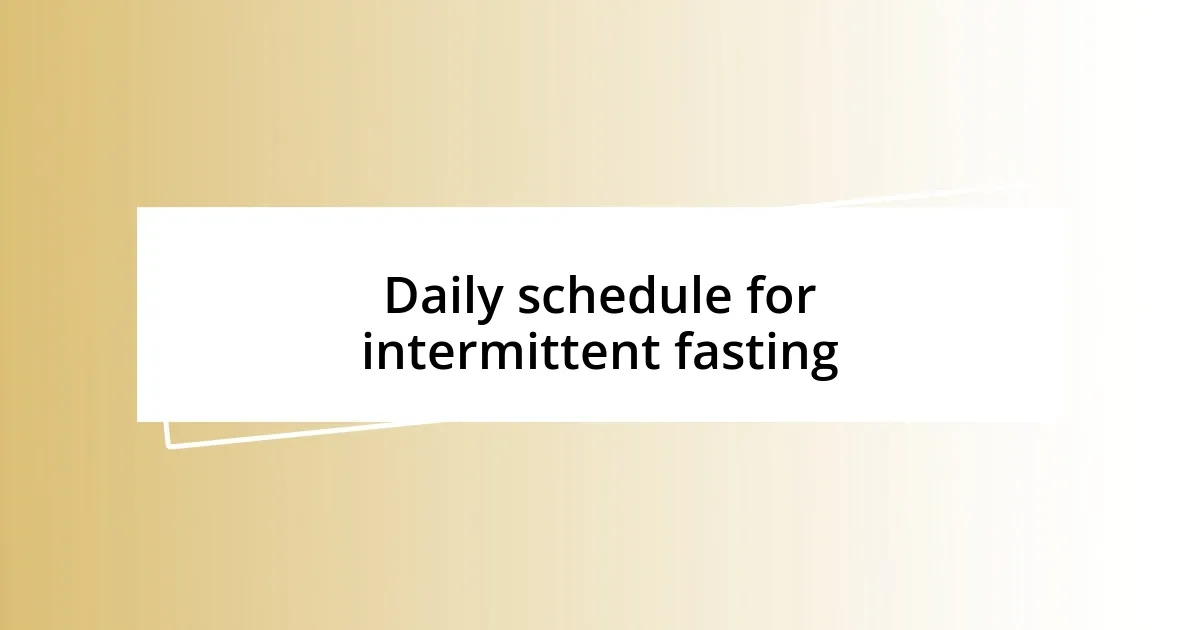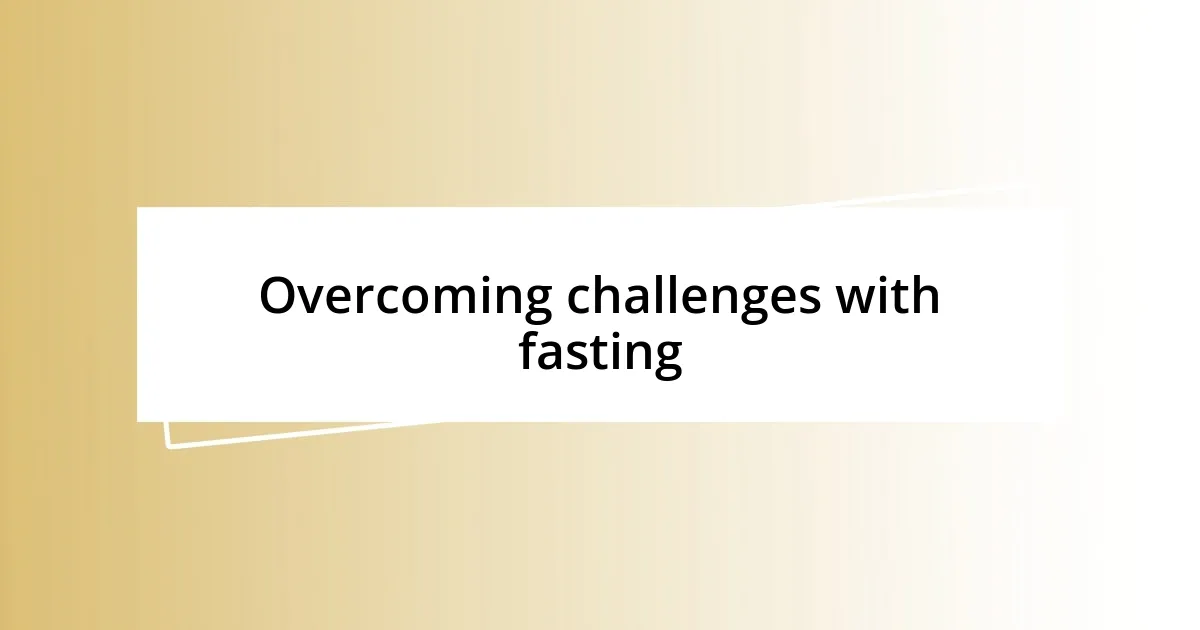Key takeaways:
- Intermittent fasting significantly improved mental clarity and emotional well-being, fostering a sense of control over cravings.
- The author experienced transformative physical changes and enhanced confidence through mindful eating practices.
- Experimenting with various fasting methods led to a personalized approach that aligned with the author’s lifestyle and energy needs.
- Meal planning was crucial in maintaining nutrient intake, turning the fasting experience into a positive and empowering journey.

Understanding intermittent fasting benefits
Intermittent fasting, in my experience, offers a surprising clarity of mind. Initially, I was skeptical, thinking how could skipping meals possibly boost mental focus? But as I dove deeper into this practice, I found that during my eating windows, I was more present and less distracted. It’s almost as if my brain hit a reset button, allowing me to tackle tasks with renewed energy.
One of the most profound benefits I’ve noticed is its impact on emotional well-being. After a month of fasting, I felt an unexpected sense of control over my cravings—like I was finally the one in charge rather than being driven by my hunger. Have you ever felt that rush of empowerment when you overcome a temptation? It’s exhilarating and contributes to a stronger mindset overall.
Additionally, I’ve experienced remarkable physical changes that made me a staunch advocate for intermittent fasting. The gradual decrease in body weight came with a noticeable boost in confidence. I remember fitting into clothes that felt tight just months before; it’s like rediscovering a part of myself that was hidden under layers of doubt. With these shifts, I wonder, isn’t it fascinating how a simple change in our eating patterns can lead to such profound transformations?

My intermittent fasting journey
My intermittent fasting journey has been filled with both challenges and rewarding moments. I remember the first few days were tough—I had moments when I felt grumpy and fatigued. Yet, as the days progressed, something shifted. I started to appreciate the simplicity of my eating routine. Instead of obsessing over what to eat, I became more mindful during meal times, savoring every bite.
- Those initial hunger pangs transformed into periods of clarity.
- I learned to listen to my body—it was no longer about mindless eating.
- Fasting introduced me to the idea of intentional eating, which was refreshing and liberating.
Looking back, my most memorable moment came when I attended a family gathering where food was the centerpiece. Instead of feeling deprived, I felt empowered. I chose my favorite dishes in moderation, enjoying the experience without guilt or regret. It was a turning point that reinforced my commitment to intermittent fasting—it’s amazing how this journey can reshape not just your habits but also your relationships with food and family.

Choosing the right fasting method
Choosing the right fasting method can feel overwhelming, especially with so many approaches available. I tried a few styles, from the 16/8 method to more extended fasts, and each brought unique challenges and rewards. If you’re like me, you’ll want a method that aligns with your lifestyle and energy levels. It’s important to reflect on how you feel throughout the day and what your daily schedule looks like.
When I experimented with the 5:2 method, I found that the two fasting days felt manageable once I got the hang of it. However, if you have a busy schedule or need to maintain steady energy, the alternate day fasting method might be more suitable for you. There’s no one-size-fits-all solution; it’s about listening to your body and adapting the method to suit your needs.
As I navigated through these various approaches, I realized that flexibility is key. I’ve found joy in mixing fasting methods to see what works best for me on different days. Sometimes I opt for a longer fast when I have a quieter work schedule, allowing my body to adapt and thrive. And don’t forget, experimentation can lead to a fulfilling experience, making it essential for you to chart your own path.
| Fasting Method | Description |
|---|---|
| 16/8 Method | Eat during an 8-hour window and fast for 16 hours. Ideal for daily routine. |
| 5:2 Method | Eat normally for 5 days and restrict calorie intake (about 500-600) for 2 days. |
| Alternate Day Fasting | Alternate between fasting days and eating days. May be more challenging but can yield results. |

Daily schedule for intermittent fasting
When I started implementing intermittent fasting into my daily life, I decided on a straightforward 16/8 schedule. This meant I would eat from noon to 8 PM, which fit perfectly into my workday. It was fascinating how, after a couple of weeks, my body adapted seamlessly to this rhythm—it became a new normal that felt surprisingly liberating.
I remember the first time I broke my fast with a homemade smoothie. It wasn’t just about fueling my body; it was a ritual I looked forward to each day. I often thought, “How could I have once dreaded this?” The anticipation of that first sip brought joy and made me appreciate my meals even more. This time window allowed me not only to prioritize nutritious meals but also to engage with family during dinner, creating meaningful conversations around the table.
As I’ve continued with my fasting schedule, I’ve noticed the importance of being flexible. For instance, on days I knew I’d be out late, I shifted my eating window to accommodate that change, which helped me avoid the feeling of restriction. Isn’t it amazing how adapting can enhance our experience? Intermittent fasting taught me not just discipline, but the joy that comes from listening to my body and responding to its needs.

Overcoming challenges with fasting
When I first started intermittent fasting, I encountered moments of hunger that felt all-consuming. I remember sitting at my desk, staring at the clock, just willing the hours to pass by. I learned quickly that drinking water or herbal tea could make a world of difference; I would often ask myself, “Is it hunger or just boredom?” This realization helped me differentiate between genuine hunger and my mind playing tricks.
Social occasions also posed a challenge for me, especially during family gatherings when meals revolved around food. I can vividly recall a birthday party where delicious cakes and tantalizing dishes surrounded me while I stuck to my fasting routine. However, I shifted my focus to enjoying the company and conversations. It struck me that I could savor the atmosphere instead of just the food, and that made the experience far richer.
Over time, the initial struggle transformed into a powerful sense of accomplishment. One day, when I concluded a prolonged fast, I felt an undeniable sense of clarity and energy that caught me by surprise. Could this newfound vitality be worth the challenges I faced? The answer was a resounding yes. Embracing these hurdles taught me resilience, and over time, I started viewing each difficulty as an opportunity for growth. Isn’t it fascinating how the mindset shift can turn challenges into stepping stones?

Meal planning during fasting
Meal planning during fasting was a game changer for my experience with intermittent fasting. I quickly realized that pre-planning meals made a huge difference in ensuring I got all the nutrients I needed within my eating window. One Sunday, I dedicated an afternoon to meal prep, creating colorful veggie stir-fries, protein-packed salads, and wholesome snacks. Seeing those vibrant meals in the fridge not only made me excited to eat but also gave me a sense of accomplishment as I set myself up for the week ahead.
I began jotting down my meals in a simple journal, which became my roadmap during the fasting period. It was comforting to have a plan—it almost felt like having a secret weapon against impulsive eating. There were times I’d glance at my notes and think, “Wow, I really am eating well!” This reinforcement helped me stay on track and feel confident in my choices, especially on days when cravings would hit hard. It’s interesting how a little bit of organization can transform the experience of fasting into a positive and empowering journey.
I also learned to incorporate flexibility into my meal planning, which was essential for maintaining balance. Some weekends, I allowed myself the freedom to experiment with new recipes, maintaining that sense of adventure while staying within my intermittent fasting guidelines. For example, one weekend, I tried a quinoa and black bean bowl that unexpectedly became a favorite. It’s moments like these that make me wonder—how can something as simple as meal planning revolutionize your relationship with food? By embracing that flexibility, I turned what could have felt like deprivation into an opportunity for creativity and enjoyment.

Results and reflections on fasting
The results I experienced from intermittent fasting were nothing short of transformative. Initially, I was skeptical, wondering if I would see any real benefits. After a few weeks, however, I felt more energized and focused than ever. It’s astonishing how the body’s adaptation to a fasting schedule can lead to heightened mental clarity. Have you ever noticed how some changes gradually become integral to your daily life? For me, that shift was palpable.
Reflecting on my journey, I realized that it wasn’t just about the physical changes—my perspective on food evolved significantly. Instead of seeing meals as routine, they transformed into mindful experiences. I recall one evening sitting down to a simple meal of grilled salmon and asparagus. As I savored each bite, I felt gratitude for the nourishing food in front of me. It made me wonder, has your relationship with food deepened through practices that encourage mindfulness? For me, it became about appreciation rather than just consumption.
Ultimately, intermittent fasting taught me resilience and patience. I faced days of doubt—wondering if it was worth the effort—but looking back, I’m grateful for those moments. They’ve shaped my understanding of discipline and reward. Sometimes I question whether I would have reached this level of growth without the challenges. Isn’t it remarkable how our toughest experiences can lead to the greatest personal revelations? This journey has shown me that fasting isn’t just a diet; it’s a catalyst for self-discovery.














